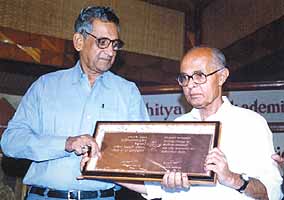
 |
|
A profile of Nilmoni Phookan
Poetry is the voice of humanity for him and each poem is a human
moment...Moment of inexpressible joy and sorrow, culminating in a silent but sure
regeneration of awareness.
Eminent Assamese poet and art critic Nilmoni Phookan, this year’s recipient of the
Sahitya Akademi Fellowship, its highest honour, says that wherever there is man, there
is poetry, and poetry enlivens all - the living and the inanimate, alike.
"Poetry is the voice of humanity. Whenever one tries to listen, each person can hear in
the quietness of his own mind the flowing cadence of dawn and dusk, of truth and
beauty", says Phookan.
Poetry is imperishable and eternal as man has immense faith in love, strength, peace,
unity, beauty and creativity while "the worship of the indivisible life itself is the
supplication of the poet".
Phookan is the youngest of the group of poets, who, influenced by the French symbolist
poets as well as the imagists and formalists of the west, established themselves in
Assam after the Second World War. But none has set these trends in modern
Assamese poetry more than Phookan.
Phookan points out that C G Jung had once remarked that modern man is searching for
a soul and "I believe it is through poetry that one day he will find that soul....He will
find a clue to a world of love.
Referring to the honour bestowed on him by the Sahitya Akademi, Phookan says, "in the
midst of numerous limitations, during the last forty-five years I have devoted myself to
the pursuit of art and literature with utmost sincerity. I consider this award to be a
literary and social recognition of this modest enduring effort.
Phookan’s poetry is replete with images of the sunflower, house, river, trees, mountains,
snow-covered peaks and that he introduced in Assamese poetry.
"Phookan’s poetry in their construction seem to be simple, but there is a complex
pattern of experiences at an inner level and the experience takes the reader into
regions of what can be called racial memories and the unconscious recesses of the
individual mind," Sahitya Akademi president Ramakanta Nath says.

Phookan receiving an award. During the eighties, Phookan’s poetry becomes more socially conscious and in some of the poems there is a stark simplicity of diction and new tone of urgency but the intrinsic strength of the poetry still lies in concrete visual imagery and the metamorphical use of language, Nath says. Many of Phookan’s poems bear witness to his intimate knowledge of traditional Japanese and Chinese poetry. He selected and translated Japanese poems from the seventh century onwards and brought out an anthology of Japani Kavita (Japanese Poetry, 1971) and a similar anthology of Chinese poems under the title, Cheena Kavita (Chinese Poetry, 1996). His other published works are Garcia Lorcar Kavita, Kuri Sataker Asomiya Kavita, an anthology of 20th century Assamese poetry, Loka Kalpadristi (Folk Vision), a book on Assamese folk art, Rupa Barna Bak, (image, colour, and language) essays on art and artists, Silpakalar Upalabdhi Aru Ananda, lectures on art appreciation and Silpakala Darshan, essays on art and artists.  Courtesy: The Hindustan Times (1998) Read Nilmoni Phookan’s Poems
|
 |
 |